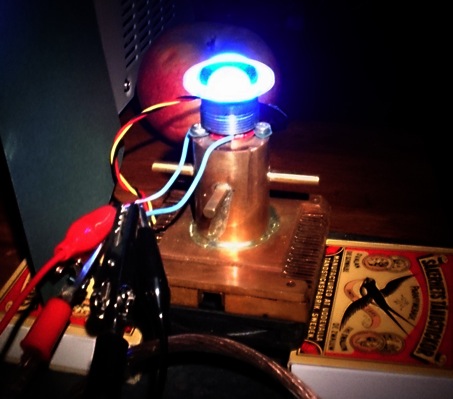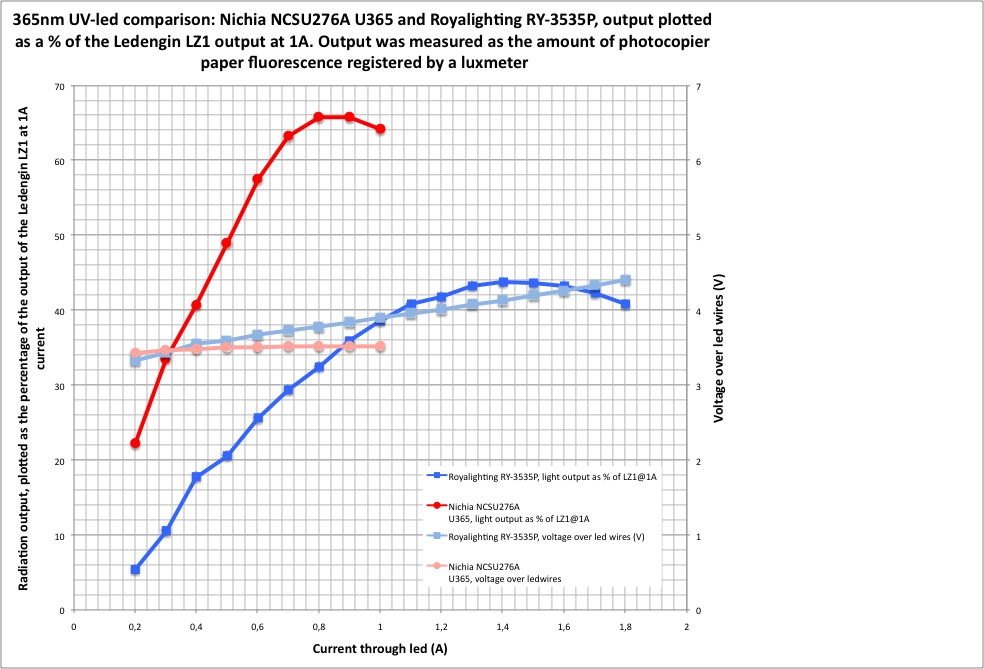Edit 4-25-2016: I re-did the output test of this led using my improved method, result in post #23.

This is an output test of one of the three fairly new Nichia UV leds (each comes in several wavelengths). This one has a dome and is the 'high efficiency' version (max current 700mA, 365nm version is 780mW@500mA), the others are a 'high power' (max current 1400mA, 365nm version is 1000mW@1A) and a 'mid-power' (700mA max current, 365nm version is 148mW@500mA) version, and the appearance of each is quite different. I chose this one because of good output and not the least because it is 20 euro's cheaper than the high power one. The peak output is at 365nm. I payed 37.90 euro's plus 6 euro's shipping from leds.de (Lumitronics). It came on a 10x10mm miniboard and I sticked for the test to that board because the led has no separate thermal pad but the two-pad lay-out that is the same as the Nichia119 series. So no DTP-copper-board adventures here unfortunately.
The test set-up was the same as what I did with the Royalighting RY-3535P UV-led: the ledboard was mounted on a cooled copper mount, a reflector was placed on top, direct on top of the reflector a piece of copier paper, then a plastic aspheric lens for some collimation but mainly to stop residual UV-light getting out in the wild, and last at 13.2 cm above the lens (why 13,2 ?  ) cm a luxmeter. Here's a picture of the set-up copied from the other thread:
) cm a luxmeter. Here's a picture of the set-up copied from the other thread:

I will compare the output results of this led to the Ledengin LZ1 365nm led and the Royalighting led, but mind that everything is nothing more than a rough approximation: I never did a proper output test on the Ledengin LZ1, during the Royalighting RY-3535P testing I measured the LZ1 output at just one current, and that one current was round and about 1A (the led was inside a flashlight with a boost driver, I measured the current once), and used a different reflector (should not really matter much though). Furthermore for this Nichia test I used a different piece of copier paper (although of same brand and batch) and who knows how constant the fluorescence output of copier paper is from piece to piece???
So take the following data as 'ballpark' numbers, any output claim can easily be 10% off (the voltages are precise though, and currents are not far off). I plotted the new Nichia results into the graph from the Royalighting RY-3535P thread, for comparison:

*So what are we looking at? Say that the Ledengin LZ1 was indeed 1430mW@1A (according to specs that is), then the Nichia at 500mA would be 49% of that, so 700mW, not far from the 780mW from the specs. Actually I do not deserve such close results with these very unprecise measurements ;-) . The maximum output of the Nichia, at 800mW, would be about 950mW.
*I now realise that I made a mistake in the Royalighting RY-3535P thread, I used 1000mW as the spec'ed LZ1 output at 1A, while it is 1430mW, the 1000mW was at 700mA. Sorry for that (did anyone notice?), and I will correct that over there. It increases the maximum measured output of that chinese uv-led to 600mW instead of 420mW. Oops!
*Clear is that this Nichia performs way better than the chinese led, the voltage stays low, the maximum output is better and at a way lower current, it is almost 3 times as efficient!
*the Nichia can not handle much higher current than 700mA continuously. The voltage is hardly going up at all in the entire range (setting the current on my power supply was not easy because of this) and after having been at 1A, the performance at lower currents had gone down a bit (a few %). So my advice for this led: stick to 700mA max! (I can not relate to the quality of the Lumitronics ledboard used here, I assume it will perform standard for a non-DTP ledboard)
*the Ledengin LZ1 has the better output, but mind that this Nichia has a die that is about 4 times smaller, so the luminosity of the Nichia led is way higher: for what that is worth, it will throw much better. (left=Nichia, right=Ledengin)

Next step is building this led into a flashlight and do some illuminiation shots. I can already tell from playing with this led at 50mA with a led-tester (as was also the experience from mash.m over at CPF) that the amount of visible light is way less than the Ledengin and Royalighting leds. Combined with the smaller die, for me that that makes this Nichia led preferable over the Ledengin LZ1, but a bit of visible light might be useful for some occasions.

tobecontinuedwithilluminiationpictures..
